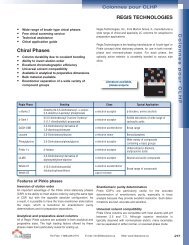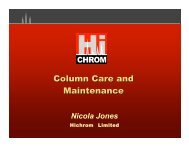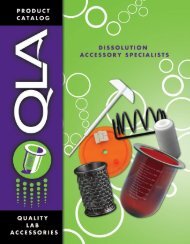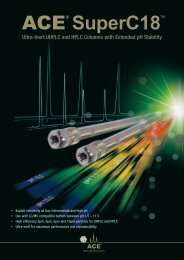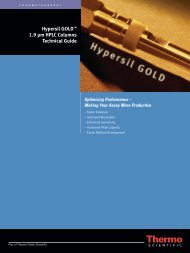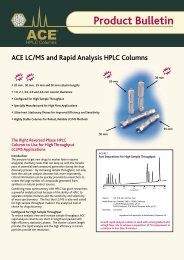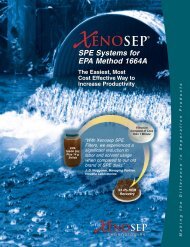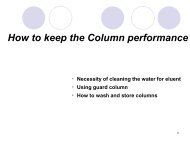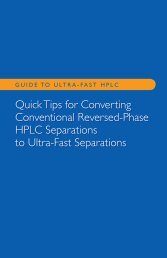Background of Size Exclusion Chromatography - Canadian Life ...
Background of Size Exclusion Chromatography - Canadian Life ...
Background of Size Exclusion Chromatography - Canadian Life ...
- No tags were found...
You also want an ePaper? Increase the reach of your titles
YUMPU automatically turns print PDFs into web optimized ePapers that Google loves.
S P E C I A L I S T S I N C H E M I C A L T E S T I N G A N D L C P R O D U C T S
INTRODUCTIONJordi FLP specializes in polymeric chromatographymedia for Gel Permeation (GPC) and Gel Filtration(GFC) <strong>Chromatography</strong>. Our GPC and GFCcolumns represent over 25 years <strong>of</strong> continuousdevelopment effort. Jordi also operates one <strong>of</strong> thelargest GPC service laboratories in the country. Itis this combination <strong>of</strong> analytical expertise and theinteraction with our customers which has resultedin the development <strong>of</strong> our revolutionary columnmedia. Our unwavering commitment to quality andcustomer service ensures that you are getting thefinest GPC and GFC columns on the market today.It also ensures that we will be here to provide thesupport you need after your purchase.BACKGROUND OF SECGPC and GFC are separation techniques basedon hydrodynamic volume (size in solution).Molecules are separated from one another basedon differences in molecular size. This techniqueis <strong>of</strong>ten used for polymer molecular weightdetermination. GFC is defined as sized basedseparation performed in an aqueous mobilephase and is typically applied for protein analysisor for water soluble polymers. GPC is performedin organic mobile phases and is used mostlyfor synthetic polymers. A broader term whichencompasses both <strong>of</strong> these separation methods issize exclusion chromatography (SEC). Jordi <strong>of</strong>ferscolumns for all types <strong>of</strong> size based separations.SEC is accomplished by passing the samplethrough a porous media. Larger molecules cannotaccess some <strong>of</strong> the pores and exit the columnmore rapidly. Smaller molecules penetrate intomore <strong>of</strong> the porous structure and elute at longerretention times. Figure I shows the path which twodifferent molecules take when passing through anSEC column. The red molecule cannot fit within thepores <strong>of</strong> the gel while the blue molecule fits into allthe pores <strong>of</strong> the gel increasing the time required topass through the column.Fig. IGPC differs from most other methods <strong>of</strong>chromatography in that separations areaccomplished without interactions between thestationary phase and the sample. Interactionsare undesirable and prevent a purely size basedseparation. This can be contrasted with the morecommon reverse phase (RP) chromatography inwhich separation is accomplished by differencesin the hydrophobic (van der waals) interactionsbetween the column and sample components.OPTIMIZING YOUR SEC SEPARATIONSelecting the correct Jordi column for yourapplication is easy. Our extensive applicationdatabase contains hundreds <strong>of</strong> methods for theanalysis <strong>of</strong> most commercially available polymers.You can search by polymer name through thecomplete methods database at www.jordiflp.com/applications.php. Alternatively, our chemists areavailable at any time by phone or email to aid youin selecting the Jordi product which is right for you.Call or write us today to receive your free copy <strong>of</strong> theJordi method database on CD or in print.As a general rule, hydrophilic samples are bestanalyzed on polar phases while hydrophobicpolymers should be analyzed on non-polar phases.Below is a list <strong>of</strong> the most important factors toconsider when designing your SEC separation.1. Column Chemistry (sample-column interaction)2. Mobile Phase (sample-column interaction, solubility <strong>of</strong>sample)3. Pore <strong>Size</strong> (applicable size range <strong>of</strong> the separation)4. Resolution (separating power)The first goal in any SEC separation is to preventcolumn-sample interactions. The two crucialparameters are the mobile phase and the chemistry<strong>of</strong> the stationary phase. Jordi <strong>of</strong>fers the widestselection <strong>of</strong> SEC column chemistries available fromany single column manufacturer. This provides youwith the widest possible range <strong>of</strong> tools for optimizingyour separation. Column chemistry has been poorlyexplored by other column manufacturers takingaway one <strong>of</strong> the most convenient methods tooptimize a size based separation.All Jordi columns are designed to allow extremelybroad solvent compatibility. Most Jordi columnscan be used in nearly any solvent system (water– hexanes). The only exception would be the JordiDVB and Fluorinated columns which require aminimum <strong>of</strong> 20% organic solvent. They are alsoincredibly rugged allowing the application <strong>of</strong> mobilephases which would dissolve competitors’ columnssuch as strongly acidic or basic solvents (Jordicolumns are pH 0-14 stable). This enables you toaccess the complete separating power <strong>of</strong> all <strong>of</strong> yourJordi columns and aids in the separation <strong>of</strong> sampleswith limited solubility.
The pore size selection <strong>of</strong>fered by Jordi is secondto none and covers the complete molecular weightrange. Media for the separation <strong>of</strong> moleculesranging from 100-400,000,000 molecular weightare available.Table I shows the available pore sizes and themolecular weight range which they separate. Jordirecommends that mixed bed columns be used whenyour sample molecular weight is unknown or if thesample has a broad molecular weight distribution.Jordi mixed bed columns separate an extremelywide range <strong>of</strong> molecular weights. Figure II comparesthe calibration curves for one Jordi Mixed bed (10 x250mm)column as compared to a competitors 10 6high molecular weight column. Note the greaterresolution on the Jordi mixed bed, without sacrificinglinearity or high end resolution. Specific pore sizecolumns are best used when the sample molecularweight is relatively narrow and well defined. Ultrahighmolecular weight compounds (greater than 2million molecular weight) can be separated usinghydrodynamic volume chromatography on JordiSolid Bead columns. Low molecular weight samples(oligomers and small molecules) are best analyzedon high resolution Jordi 500Å columns.Fig. IIJORDI GPC SpecificationsDescription MW RangeTable IGPC Solid Bead 2,000–400,000,000Note Tail In HighMw RegionCompetitor B10 6 Å30CM X 7.8MMGPC 100Å
Jordi Fluorinated gels represent one <strong>of</strong> the mostexciting breakthroughs in GPC technology. Thispatent-pending technology provides a non-sticksurface chemistry for significantly reduced samplecolumninteractions. Example applications includethe analysis <strong>of</strong> phenolic resins, polyacrylamides, andnovel drug delivery polymers in polar solvents such ahexafluoroisopropanol (HFIP). This gel has also beenapplied where PS-DVB columns fail allowing theapplication <strong>of</strong> more convenient mobile phases suchas THF. Column back pressure is greatly reduced onJordi Fluorinated columns allowing high flow ratesfor decreased analysis time. This unique propertycan also be applied for the preparation <strong>of</strong> ultrahighresolution GPC column sets generating over250,000 plates per meter.Jordi Glucose and Hydroxylated columns bridge thegap between aqueous and organic SEC columns.Hydroxylated DVB columns have been applied forthe analysis <strong>of</strong> hydroxypropylmethylcellulose (HPMC)and its derivatives. Jordi Glucose columns are morepolar and are typically used in water/polar organicmixtures. Both columns are compatible with 100%organic mobile phases. Jordi Glucose columns canalso be applied in 100% aqueous solution but aremore commonly used in polar organic solvents suchas dimethylsulfoxide (DMSO), dimethylacetamide(DMAC), or dimethylformamide (DMF). Typicalapplications for these packings include the analysis<strong>of</strong> polysaccharides and other polar polymers.JORDI GFC — AQUEOUS SOLVENTSJordi <strong>of</strong>fers three column chemistries for analyses inaqueous mobile phases including:5. Jordi Glucose DVB (neutral)6. Jordi Sulfonated DVB (negatively charged)7. Jordi Polar Pack Wax (neutral or positively charged)Aqueous applications represent some <strong>of</strong> themost challenging size based separations. Thisis a result <strong>of</strong> the difficulty in preventing samplecolumninteractions. Jordi <strong>of</strong>fers you the widestselection <strong>of</strong> aqueous column packings toachieve your GFC separation.4 M i l l S t , B e l l i n g h a m , M A . 0 2 0 1 9 U S AJordi Glucose DVB columns allow the separation<strong>of</strong> samples in mixed aqueous/organic mobilephases. They have been used for neutral polarsynthetic polymers and polysaccharides in mixedmobile phases such as DMSO/H2O. The incredibleinertness <strong>of</strong> these packings has allowed theirapplication in strongly basic mobile phases suchas 1M NaOH. These conditions would destroycompetitive methacrylate based products.Jordi Sulfonated and Polar Pack DVB columnsare for the analysis <strong>of</strong> charged polymerswithout the need for high salt concentrations.Sulfonated columns have a negatively chargedsurface allowing the separation <strong>of</strong> negativelycharged polymers such as poly(styrenesulfonate). Typical mobile phases includeaqueous/organic mixtures such as water/Methanol. Jordi Polar Pack Wax columns havea tertiary amine group which is converted tothe positively charged quaternary amine inweakly acidic mobile phases. This allows theseparations <strong>of</strong> positively charged polymers suchpoly(ethyleneimine) in mobile phases such aswater/acetic acid mixtures. These columnsare an excellent choice for light scatteringanalyses in which high salt concentrations are ahindrance to system performance.



